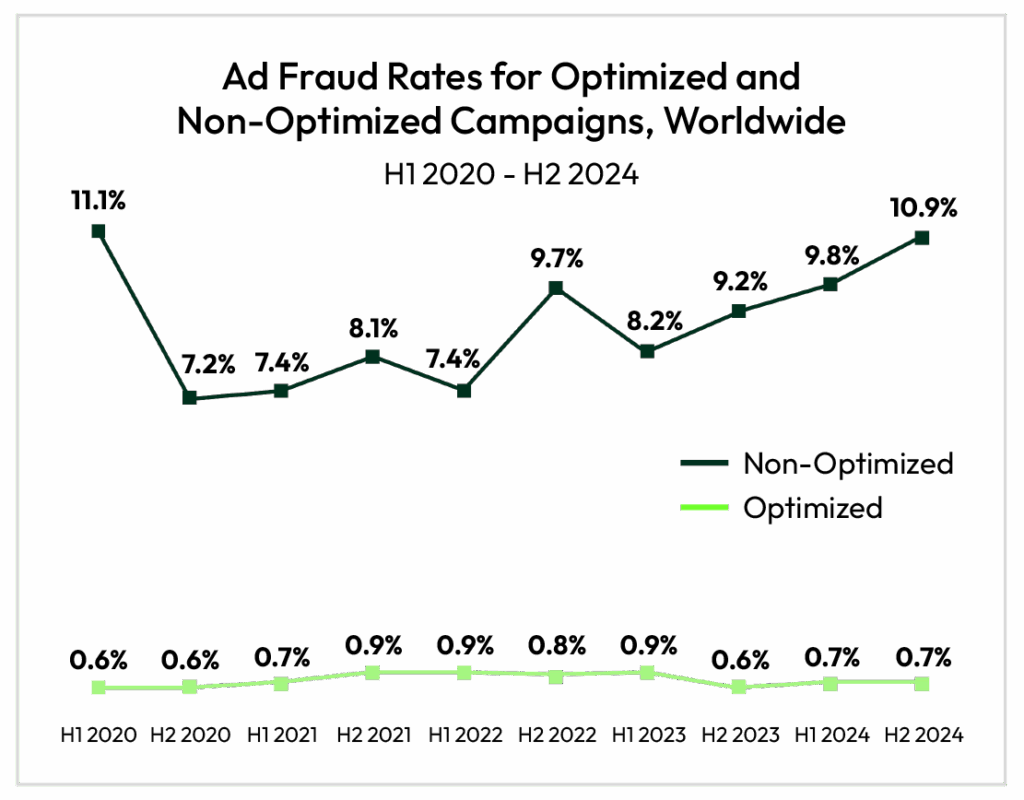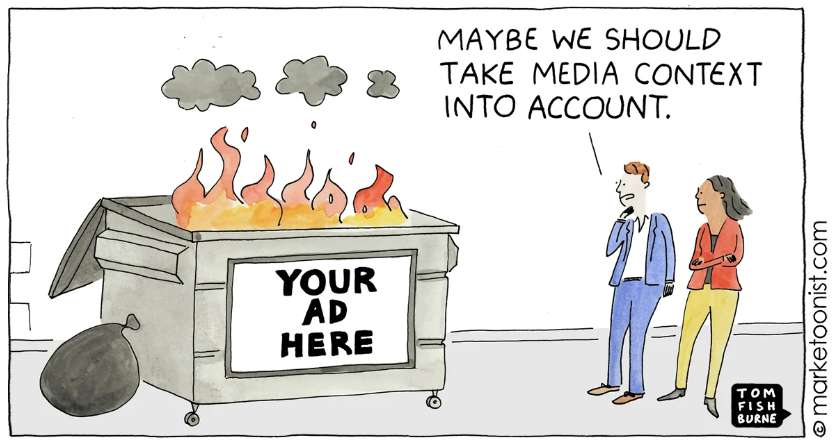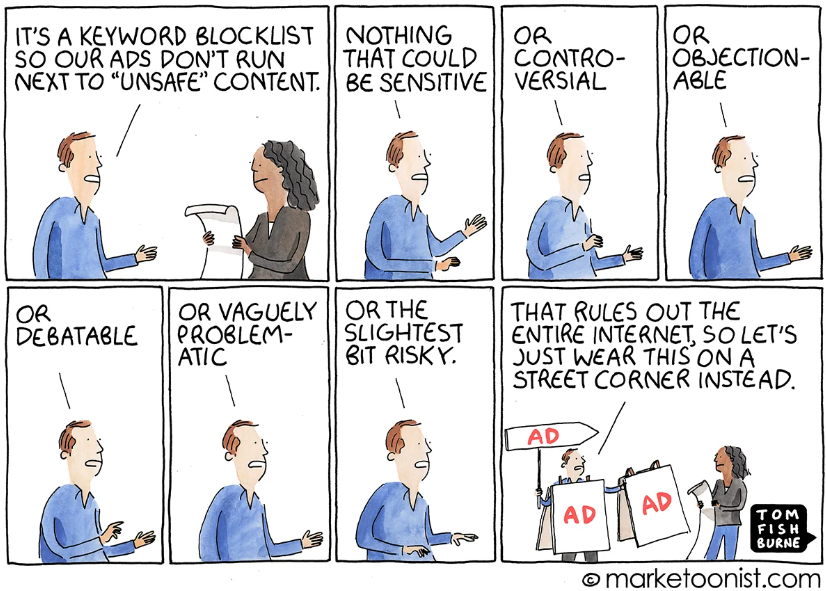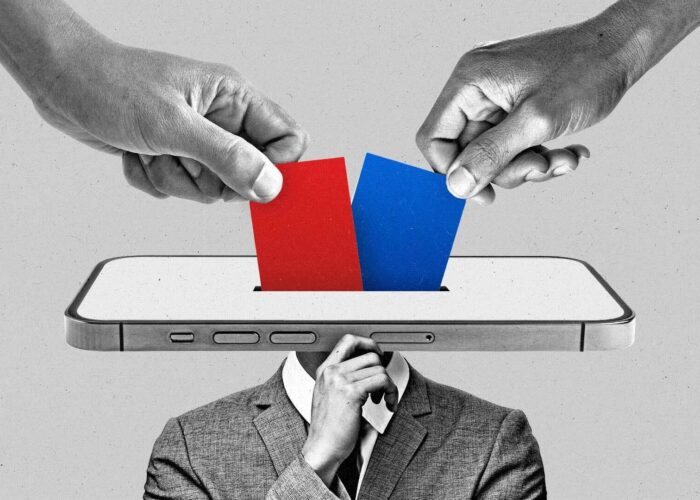With every passing day, new platforms emerge, consumer attention splinters, AI-generated content floods the ecosystem, and the stakes for brand integrity rise. In this environment, media quality and brand safety are no longer technical concerns for media buyers – they’re strategic imperatives for marketers, CMOs, and CEOs alike.
According to the 20th Edition of the IAS Media Quality Report (MQR), the media quality picture is more complex than ever. While global viewability rates have stabilized, non-optimized ad fraud rates have surged 19% year-over-year, and offensive language and hate speech are re-emerging as top brand risks, particularly in the U.S.
But it’s not all bad news. As threats grow more sophisticated, so do the tools and strategies used to combat them. Thanks to advancements in data science, AI, and ad tech, today’s marketers can take greater control of where their ads appear, who sees them, and what those placements mean for their brand’s reputation and ROI.
This blog unpacks the changing landscape of media quality and brand safety, explores the technologies that are reshaping how we protect brands, and offers best practices for turning media quality into a competitive edge.
Media Quality 2.0: From Visibility to Value
Traditionally, media quality was judged by a simple question: “Was the ad seen?” That’s still important, but it’s not enough.
Beyond Viewability: The Rise of Attention
While global viewability rose to a strong 76.8% in H2 2024, the real shift is in how advertisers are rethinking performance. Instead of optimizing solely for viewability, brands are embracing attention: a more nuanced measure of ad impact that considers dwell time, scroll behavior, ad clutter, and even eye-tracking data.
This shift is changing how we value impressions. A “viewable” ad that garners no engagement is no longer acceptable. Now, the question is: “Did the ad capture attention, and did it move the audience closer to action?”
From Brand Safety to Brand Suitability
In the early days of digital media, brand safety meant avoiding obviously harmful content: adult sites, violence, illegal downloads. Today, advertisers are expected to navigate more subtle and subjective terrain.
Enter brand suitability.
Brand suitability takes context, tone, and content alignment into account. A campaign promoting financial responsibility may avoid even “safe” content like gambling tips or controversial political debates. A luxury skincare brand may want to avoid sensational celebrity gossip, even if it meets basic safety thresholds.
This evolution reflects a growing truth: brand safety isn’t binary – it’s personal. And with the right tools, brands can now tailor ad environments to match their values, goals, and audience sensitivities.
The Threat Landscape: What Brands Are Up Against
While media quality tools are improving, so too are the tactics of bad actors and the complexity of the content ecosystem. The IAS report highlights three critical threats:
1. Non-Optimized Ad Fraud is Surging
Ad fraud siphoned off an estimated $100 billion in ad spend in 2024. Alarmingly, the rate of fraud for non-optimized campaigns hit 10.9% – a four-year high. Even worse, the volume of campaigns running without fraud protection rose 81% globally, signaling a dangerous overreliance on outdated verification methods.
Fraudsters are growing bolder and smarter, using AI to create spoofed websites, botnets that mimic human behavior, and fake CTV impressions. These tactics undermine both ad effectiveness and trust in the media supply chain.

2. Offensive Language and Hate Speech Are Climbing Again
Despite a global drop in overall brand risk (down 10.6% YoY to 1.5%), offensive language and hate speech are growing fast. IAS reported a 72% year-over-year spike in offensive content globally in 2024, with the U.S. seeing a 28% increase, driven by political polarization, AI-generated content, and rising toxicity on social platforms.
Hate speech accounted for 9.8% of all risky content in early 2024. In EMEA, that number reached 15% in some markets.
Consumers are taking notice: 68% believe it’s inappropriate for brands to appear next to hate speech, and 51% say they’d stop using a brand whose ads appear near controversial content.
3. Contextual Blind Spots in Mobile and Programmatic
While desktop video viewability hit a record 83.9%, mobile app display viewability dropped 4.6% to a four-year low. Why? Cluttered interfaces and aggressive ad stacking in apps are driving consumers to scroll past ads faster than ever.
Programmatic channels, though powerful, remain vulnerable to spoofing, MFA (Made-for-Advertising) content, and a lack of transparency. Without optimization, they can expose brands to significant quality and suitability risks.
How Data Science Is Changing the Game
As the threat landscape evolves, so does the defense. Thanks to AI and data science, marketers now have access to smarter, faster, and more context-aware tools to protect brand integrity and drive performance.
AI-Powered Contextual Intelligence
 Machine learning models now analyze text, video, audio, and imagery to assess:
Machine learning models now analyze text, video, audio, and imagery to assess:
- The tone and sentiment of content
- Visual threats, such as weapons or adult imagery
- Audio transcription for hate speech or explicit language
- The presence of synthetic or AI-generated content
Instead of simply blocking keywords, these systems understand what a page or video is actually about, unlocking precision-level suitability.
Predictive Fraud Detection
Rather than waiting to flag fraudulent impressions post-delivery, AI models now:
- Analyze behavioral anomalies (e.g., 1,000 clicks from the same IP in 10 seconds)
- Score traffic sources and device IDs in real time
- Proactively exclude suspicious inventory during pre-bid filtering
As a result, optimized campaigns show fraud rates 15x lower than unprotected ones.
Unified Attention Measurement
Advertisers are now tying together time-in-view, scroll rate, hover time, and post-view actions into a single attention score, allowing them to buy based on quality, not just quantity.
This is the foundation of qCPM (Quality CPM) models, which align ad pricing with real performance – not inflated impression counts.
The Role of Ad Tech: Turning Insight Into Action
Data science provides the intelligence, but ad tech enables the execution. Here are the key tools helping brands put media quality insights to work:
Verification Platforms
IAS, DoubleVerify, and Moat offer verification across viewability, fraud, brand safety, attention, and suitability, often integrated across web, CTV, mobile, and social.
These platforms help brands measure in real-time and take corrective action mid-campaign.
Pre-Bid Targeting and Real-Time Filters
Modern DSPs offer pre-bid filtering, allowing brands to exclude:
- Fraudulent domains
- MFA content
- Unsafe categories (e.g., hate, violence, adult)
This ensures that every impression meets baseline quality standards before a dollar is spent.
Creative Optimization with AI
DCO (Dynamic Creative Optimization) uses machine learning to adjust creative assets in real-time, ensuring that ad copy, imagery, and calls-to-action match the content and context of each impression.
Supply Path Optimization (SPO)
SPO tools reduce reliance on indirect resellers, minimize fees, and cut fraud risk. When combined with standards like ads.txt and sellers.json, SPO ensures your media dollars are flowing to trusted, transparent partners.
Best Practices: Laying the Foundation for Media Quality Excellence
Achieving excellence in media quality and brand safety requires more than installing a verification tag or updating an exclusion list. It demands a cultural and operational shift that aligns your brand’s values with every impression you buy. The most successful brands treat media quality not as a box to check, but as a dynamic, performance-driven discipline embedded in every stage of the advertising lifecycle with several key best practices and safeguards.
-
Define Brand Safety and Suitability Standards
-
Implement Always-On Verification and Optimization
-
Align Creative with Contextual Relevance
-
Perform Routine Media Quality Audits
-
Foster Cross-Functional Collaboration
-
Practice Makes Performance
Define Brand Safety and Suitability Standards
The first best practice is to clearly define your brand’s safety and suitability standards. This goes far beyond avoiding obvious categories like adult content or violence. It involves articulating the tone, themes, and contexts that either support or erode your brand equity. For one brand, political commentary might be acceptable; for another, it may pose too great a reputational risk.
Codifying these preferences into internal guidelines and aligning them across markets, languages, and content verticals is essential. It allows all stakeholders, from media buyers to creative leads, to operate from the same strategic playbook, ensuring consistency and control in an increasingly fragmented digital landscape.
Implement Always-On Verification and Optimization
Verification is not a one-time setup – it’s a continuous process. Leading brands deploy always-on verification tools that monitor campaign data in real time across viewability, invalid traffic, and brand risk. These tools are not passive metrics repositories; they’re active guardrails.
Smart advertisers build alert systems and automated responses to flag anomalies such as a sudden spike in suspicious traffic or a drop in attention rates. More importantly, they use these insights to take immediate action, redirecting spend, blocking unsafe placements, or recalibrating targeting parameters while campaigns are still live. This level of agility turns media quality into a real-time performance advantage.
Align Creative with Contextual Relevance
 Media quality doesn’t end with placement; it extends to creative execution. High-quality impressions are those that not only appear in suitable environments but also deliver messages that resonate. Savvy brands understand that a well-placed ad can still underperform if its creative clashes with the surrounding content or fails to engage the audience in that environment.
Media quality doesn’t end with placement; it extends to creative execution. High-quality impressions are those that not only appear in suitable environments but also deliver messages that resonate. Savvy brands understand that a well-placed ad can still underperform if its creative clashes with the surrounding content or fails to engage the audience in that environment.
Creative teams and media strategists should collaborate from the outset to adapt messaging for specific channels and formats. Whether it’s optimizing for CTV storytelling, mobile scrollers, or in-feed social placements, context-aware creative increases attention, improves recall, and boosts conversion.
Perform Routine Media Quality Audits
Just as financial health requires regular audits, so does media quality. Top-performing brands conduct routine reviews of campaign performance with a specific lens on media integrity. These audits look at which domains and platforms are delivering attention-rich, fraud-free impressions and which are wasting spend or introducing reputational risk.
The results inform future campaign planning, vendor negotiations, and budget allocations. They also spark internal discussions that move media quality from a back-end function to a central KPI that influences both marketing strategy and business outcomes.
Foster Cross-Functional Collaboration
Media quality is not the sole responsibility of the media team – it intersects with legal, compliance, brand, creative, analytics, and procurement. Brands that lead in this space treat media integrity as an enterprise-level priority. They establish internal governance frameworks, such as brand safety councils or cross-functional task forces, to ensure alignment, accountability, and strategic cohesion.
This level of collaboration ensures faster decision-making in times of crisis, better response to emerging threats, and a unified voice across every touchpoint. In practice, it turns brand safety from a reactive concern into a proactive brand asset.
Practice Makes Performance
Ultimately, the brands that excel in media quality don’t just avoid harm – they maximize impact. Through clearly defined standards, real-time monitoring, contextual creative alignment, regular audits, and integrated team structures, these organizations treat media quality as both a brand defense and a growth accelerator.
In today’s AI-powered, content-saturated world, these best practices are no longer optional. They are the foundation for advertising that is trusted, targeted, and truly effective.
Building a Roadmap for Brand and Ad Safety: How to Audit, Prioritize, and Evolve
Achieving brand safety excellence isn’t about flipping a switch, but a strategic journey. For many brands, the challenge lies not in recognizing the importance of media quality, but in knowing where to start, what to prioritize, and how to scale.
The good news? You don’t have to guess. With a structured audit and a clear roadmap, brands can evolve from basic compliance to high-performance media governance. Here’s how.
Step 1: Conduct a Media Quality & Brand Safety Audit
Begin by evaluating where your organization stands today. A media safety audit should assess performance, infrastructure, and vendor alignment across five key dimensions:
1. Policy & Standards
Do you have a formal brand safety and suitability policy?
Are risk thresholds defined by category (e.g., hate speech, adult, political)?
Is your policy adapted for different markets or cultural nuances?
2. Verification Tools
Are you using third-party verification for viewability, fraud, and brand safety?
Are your tools set up for all environments (web, mobile app, CTV, social)?
Are pre-bid filters being applied proactively?
3. Ad Tech & Media Buying
Are you using Supply Path Optimization (SPO) and pre-bid exclusions?
Are you avoiding MFA and low-quality inventory?
Is contextual targeting integrated into your DSP campaigns?
4. Campaign Performance
What are your current benchmarks for IVT, viewability, time-in-view, and attention?
What percentage of impressions are flagged for brand risk?
Are fraud and risk higher in certain platforms or channels?
5. Reporting & Accountability
Are you regularly reviewing verification reports?
Who is responsible for monitoring brand safety violations?
Do you have feedback loops to optimize based on insights?
Use a scoring model (e.g., red/yellow/green or maturity levels 1–5) to quickly identify gaps and opportunities.
Step 2: Define Brand Safety Maturity Goals
Based on your audit, plot a media quality maturity model. Here’s a sample roadmap:
| Maturity Level | Focus | Capabilities |
| Level 1: Reactive | Safety basics | Keyword blocking, basic fraud detection, no strategy or reporting |
| Level 2: Baseline | Compliance | Third-party verification, manual monitoring, limited contextual alignment |
| Level 3: Proactive | Policy-driven | Suitability controls, pre-bid filters, platform exclusions, whitelist curation |
| Level 4: Optimized | Performance-integrated | Attention metrics, qCPM focus, dynamic creative and contextual targeting |
| Level 5: Strategic | Brand-aligned, real-time intelligence | AI-driven modeling, global consistency, cross-channel media quality command center |
Aim to move progressively up the levels, setting quarterly or annual goals per business unit, market, or campaign type.
Step 3: Develop a Roadmap and Implementation Plan
With your audit and maturity goals defined, build a roadmap that includes:
-
Quick Wins (0–90 days):
- Activate verification across all campaigns
- Apply pre-bid brand safety filters
- Eliminate high-risk domains and MFA sites
- Draft a formal brand suitability framework
-
Mid-Term Goals (3–6 months):
- Integrate attention metrics and qCPM into planning
- Enable SPO and log-level transparency in DSPs
- Align creative strategy with contextual placements
-
Long-Term Investments (6–18 months):
- Train internal teams on brand safety dashboards
- Build or refine dynamic contextual segments
- Adopt AI-powered synthetic content detection
- Establish brand safety councils or governance structures
Each milestone should be tracked with KPIs like reduced IVT rate, lower brand risk, improved attention scores, and higher conversion quality.
Step 4: Involve Stakeholders Across Functions
Media quality is a cross-functional discipline. Your roadmap should involve:
- Marketing: Brand tone, messaging, audience strategy
- Media Buying: Platform configuration, DSP optimization
- Legal & Compliance: Risk management and regulatory alignment
- Analytics & Insights: Measurement frameworks, reporting
- Agency & Tech Partners: Tool execution, innovation, best practices
By uniting these teams, you move brand safety from an isolated function to a shared strategic objective – one that drives both trust and performance.
Why the Right Agency Partner Makes All the Difference
While building an in-house media quality infrastructure is possible, it’s increasingly resource-intensive. Between implementing fraud prevention layers, maintaining contextual intelligence systems, optimizing supply paths, and staying ahead of rapidly shifting threats, many brands are realizing they need more than just tools – they need expertise, scale, and speed.
That’s where the right agency partner becomes indispensable.
A Built-In Advantage
Working with an agency that already has advanced media quality and safety protocols built into its workflow gives brands a head start. Instead of spending months integrating new platforms, training staff, and fine-tuning optimization rules, you’re tapping into a battle-tested system that’s already:
- Pre-integrated with top-tier verification platforms (e.g., IAS, DoubleVerify)
- Configured for contextual and suitability optimization by vertical and audience
- Actively monitoring for fraud, MFA traffic, and low-attention placements in real time
- Running supply path optimization (SPO) by default to reduce waste and risk
- Measuring and optimizing for attention, not just impressions
This means faster go-to-market timelines, better media ROI, and fewer costly surprises.
Strategic Guidance Included
Agencies with deep expertise in media quality also offer something that software can’t: human strategy. A seasoned team can help you:
- Translate brand values into practical suitability frameworks
- Interpret complex verification reports and turn them into action
- Conduct partner and placement audits regularly
- Adjust creative and targeting dynamically to avoid risky adjacencies
These insights don’t just prevent problems – they enhance performance, turning media quality into a brand-building asset.
Future-Ready by Design
As fraud tactics evolve, AI-generated content proliferates, and attention becomes a standard KPI, having a partner that innovates ahead of the curve becomes critical.
At Digital Mouth, for example, media quality and brand safety aren’t an afterthought – they’re part of the DNA of every campaign. From bid filtering to attention modeling to proactive risk scoring, we’ve built an infrastructure that adapts in real time to protect every dollar you spend.
In short, partnering with the right agency doesn’t just reduce complexity – it amplifies clarity, impact, and trust across your entire media ecosystem.
Looking Ahead: The Future of Media Quality
The media landscape is moving faster than ever, but the tools to manage it are also more powerful than ever. Here’s what’s next:
- CTV and Social Video Innovation: As video becomes the dominant media format, platforms will move toward frame-by-frame content classification, enabling brands to avoid specific themes within a single episode or stream.
- AI Content Verification: With AI-generated media surging, expect widespread adoption of tools that flag synthetic content and offer content provenance tracking, ensuring ads appear alongside authentic, human-generated content.
- Attention-Driven Buying Models: In the future, brands won’t just optimize for cost per thousand, but they’ll optimize for cost per second of attention. The shift from impressions to impact will separate performance leaders from laggards.

Final Thoughts: Media Quality as a Performance Multiplier
Media quality is no longer a cost center. It’s a strategic lever that helps brands:
- Protect reputation
- Improve campaign ROI
- Build consumer trust
- Strengthen long-term brand equity
Thanks to innovations in data science, AI, and ad tech, advertisers can now ensure their dollars are spent in environments that are not only safe, but smart, aligned, and effective.
In today’s chaotic content landscape, the brands that plan, protect, and optimize their media quality will be the ones that win.
A Brand Steward in a Risk-Filled Media Landscape
At Digital Mouth, we don’t just run campaigns, we protect what matters most: your brand. In a digital environment filled with noise, risk, and rapid change, we act as a strategic steward of your media integrity, ensuring every impression reflects your values, safeguards your reputation, and drives measurable performance. Our AI-powered tools, real-time monitoring systems, and contextual intelligence are designed to shield your brand from harmful placements while elevating your presence in the moments that matter. With Digital Mouth, you gain a trusted partner committed to defending your brand equity, so you can advertise boldly, confidently, and responsibly.



